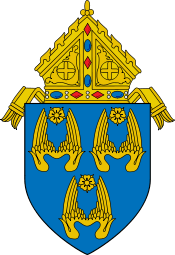
Roman Catholic (term)
The term "Roman Catholic" appeared in the English language at the beginning of the 17th century to differentiate members of the Catholic Church (in communion with the Pope) from other Christians who use the term "Catholic"; comparable terms in other languages already existed. Being "catholic" is one of the Four Marks of the Church set out in the Nicene Creed, a statement of belief accepted by many churches even if not in communion with the Pope.
In popular usage, "Roman Catholic Church" is usually understood to mean the same as "Catholic Church". The name has continued to be widely used in the English language ever since, although its usage has changed over the centuries. The church widely known as the "Catholic Church" consists of 24 autonomous churches (all of which are subject to the Pope)— one "Western" and 23 "Eastern" — governed by two sets of codes of canon law. To refer to all 24 autonomous churches together, official church documents often use the term "Catholic Church" or, less frequently, the term "Roman Catholic Church".

Catholic Church
The Catholic Church, also known as the Roman Catholic Church, is the largest Christian church, with more than 1.25 billion members worldwide. One of the oldest religious institutions in the world, it has played a prominent role in the history of Western civilisation.Headed by the Bishop of Rome, known as the Pope, its doctrines are summarised in the Nicene Creed. The Catholic Church is also notable within the Western Christian tradition for its celebration of the seven sacraments.
The Catholic Church teaches that it is the one true church founded by Jesus Christ, that its bishops are the successors of Christ's apostles, and that the Pope is the successor to Saint Peter. The Church maintains that the doctrine on faith and morals that it declares as definitive is infallible. The Latin Church, the autonomous Eastern Catholic Churches and religious institutes such as the Jesuits, mendicant orders and enclosed monastic orders, reflect a variety of theological emphases in the Church.

Latin Church
The Latin Church is part of the Catholic Church. It is described as an autonomous or sui iuris particular church. There are several such autonomous particular churches within the Catholic Church. Other examples are the Maronite Church, the Ukrainian Greek Catholic Church, and the Syro-Malabar Catholic Church. They differ from each other in liturgy (ceremonies, vestments, chants, language), devotional traditions, theology, canon law, and pastors (even if in the same territory as another), but they all hold the same faith, and all see union with the bishop of Rome, the pope, as essential to being a Catholic.
The Latin Church is the largest of these, with a membership far greater than all the others taken together. It arose in Western Europe and North Africa, an area throughout which Latin was once understood and spoken by every formally educated person. It is sometimes called the Western Church. All the other autonomous particular churches, of which there are 23, originated farther east and are, therefore, collectively known as the Eastern Catholic Churches. Because of the facility with which people can nowadays take up residence in a different country, members of all of these autonomous particular churches are no longer confined to their areas of origin and can be found all over the world.

Roman Catholic Archdiocese of Los Angeles
The Archdiocese of Los Angeles (Latin: Archidioecesis Angelorum in California, Spanish: Arquidiócesis de Los Ángeles) is an archdiocese of the Roman Catholic Church in the U.S. state of California. Headquartered in Los Angeles, the archdiocese comprises the California counties of Los Angeles, Santa Barbara and Ventura. The diocesan cathedral is the Cathedral of Our Lady of the Angels in Los Angeles, and its present archbishop is José Horacio Gómez. With approximately five million professing members, the Archdiocese of Los Angeles is numerically the single largest diocese in the United States.
The Archbishop of Los Angeles also serves as metropolitan bishop of the suffragan dioceses within the Ecclesiastical Province of Los Angeles, which includes the Dioceses of Fresno, Monterey, Orange, San Bernardino, and San Diego.
Following the establishment of the Spanish missions in California, the Holy See established the Diocese of the Two Californias in 1840, when the Los Angeles region was still part of Mexico. In 1848, present-day California was ceded to the United States, and the U.S. portion of the diocese was renamed the Diocese of Monterey. The diocese was renamed the Diocese of Monterey-Los Angeles in 1859, and the episcopal see was moved to Los Angeles upon the completion of the Cathedral of Saint Vibiana in 1876. Los Angeles split from Monterey to become the Diocese of Los Angeles-San Diego in 1922. The diocese was split again in 1936 to create the Diocese of San Diego, and the Los Angeles see was elevated to an archdiocese. The archdiocese's present territory was established in 1976, when Orange County was split off to establish the Diocese of Orange.
Podcasts:

